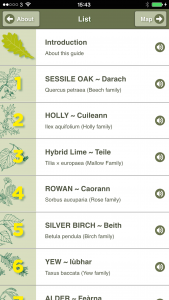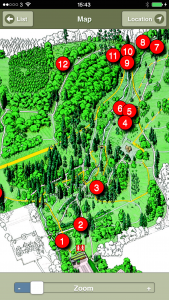Apps Apps Apps
For several years now we have been looking for a way to make appropriate use of mobile phones to deliver interpretation material.
Smart phones really kicked off with the launch of the first iPhone in 2007 and the market has now matured with very capable handsets available for little over £100. They are becoming ubiquitous especially amongst younger people with estimates of 80% of 20 to 30 year olds having one and even 50% of 50 to 60 year olds. The phones are used for texting, social media, photography, shopping, general browsing, gaming … and even making calls!
Although the penetration of smart phones presents an opportunity for enhancing visitor experiences and attracting new visitors there are major challenges.
The technical landscape is quite heterogeneous. It is dominated by Android and iOS (Apple) devices but there are a plethora of different software versions, and hardware form factors. This is especially so as the market is only just reaching maturity. A three year old phone might well lack the ability to run the latest version of an operating system even if the user wanted or knew how to upgrade.
Hype is still present. Although successful applications do a single task, especially at launch, there is still a temptation to try and create an app that does it all; builds a community, integrates with social media, sell things etc etc. Brainstorming meetings can lead to the invention of the an un-implementable mess.
The social landscape is also heterogeneous. A teenager will use a phone very differently from her parents.
Classic Audio Tours
Whilst searching for a way to use a new technology we were having issues with a slightly older one. The glass houses in Edinburgh have an audio interpretation tour consisting of some three hundred recordings delivered on dedicated audio wands. There are similar facilities at Logan and Benmore gardens. The upkeep of the hardware is becoming a burden and the units themselves are looking dated. The content is an amazing asset but the sheer amount makes management an issue. Some recordings will become out of date and may need updating but others are absolute gems we want to highlight.
Could we deliver these classic audio tours as an app? The answer is no. The sheer amount of content in the tours is too great to download and the lack of network coverage makes an online approach impractical in the first instance*. Even if we did solve the hardware issue like this it wouldn’t solve the information management issue.
Thinking about this problem led to the concept of single purpose mobile apps that contain bite size chunks of audio interpretation; what we are calling Audio Leaflets. Although not an instant solution to our audio tour challenge thinking about the problem had spawned something new and perhaps solved another problem.
Audio Leaflets
Audio Leaflets are simple, inexpensively produced mobile phone apps for delivering compelling audio interpretation of places and exhibitions. They typically contain between ten and twenty Points of Interest (POI) each with two to three minutes of commentary. They can contain a map or plan to help locate the points but have no other significant features. They can be produced entirely in house or with the help of writing and voice talent.
Audio Leaflets are not direct replacements for traditional tours but they may have a significant role to play. The main challenge we face is in thinking in new ways about how we can exploit this approach. The most important aspect of Audio Leaflets is that they encourage a modular approach. Each Audio Leaflet is a freestanding app in the app store. We could charge for one audio leaflet but not another. We could translate one leaflet and not another. Some leaflets can be ephemeral and others can be a long term commitment. But we use the same method to produce them all so the unit cost is low and we can concentrate on the content our visitors want.
Dawyck Scottish Trees
As the Audio Leaflet idea was maturing we were developing a conventional Scottish Tree Trail at Dawyck Botanic Garden. It would consist of a eighteen trees with panels in the ground and a leaflet to guide you around. We decided to make an accompanying Audio Leaflet with more information about the trail. This would give visitors the opportunity to listen to addition stories, facts and folklore about the trees as they walked the trail. It would also give us a straightforward example to try out the whole Audio Leaflet concept.
Max Coleman our science communicator, who was writing the panels and leaflet, wrote a script for the audio. We were given a small grant by The Sibbald Trust to pay Hazel Darwin-Edwards to do a professional voice over. I developed the software to run on the phone and deploy it to both Android and iOS (Apple) platforms. The crucial requirement of this software was that it separated logic from content. After Dawyck Scottish Trees was completed we should be able to put different data in, turn the handle again, and easily produce another app for another audio tour.
Most important of all the guys on the ground at Dawyck lead by Graham Stewart made sure the trees were in place and corrected the dots on our maps. No trees means no tree trail!
Today the Dawyck Scottish Trees app is live in both the Google Play store for Android and the Apple App Store for your iOS devices. You can install it and have a play by just searching for “Dawyck” in the store on your device or clicking one of the links below.
Please rate the app if you like it and if you don’t get in touch and help us make it better.
What we have proved is that the process is possible. We have learnt a lot of lessons about how the process could be done more efficiently not least of which is doing things in the right order. Our next challenge is to do it again faster and more smoothly.
Next Steps
We are coming into autumn now so there is an opportunity to test out the Dawyck app on a small audience and get any fixes in place before making a decision about publicising it more in the spring.
We are partnering with one of our neighbours, the Water of Leith Conservation Trust, to take an existing on-line audio tour for the Water of Leith Walkway and turn it into and audio leaflet. This is likely to be the next one out of the door because all the content is ready to use.
If all goes well with the first two then a general tour of the Edinburgh Inverleith site would be our next goal. This might be the first one we would charge for and perhaps translate.
If you have any comments or ideas then I’d love to hear them.
* It is likely that the glasshouses in Edinburgh will have complete public WiFi coverage in the near future and so we are considering deploying a mobile friendly web site that mimics the existing hardware and allows people to access the wealth of audio interpretation on their phones. We are also looking to take subsets of the existing audio tour and repurposing them as Audio Leaflets. I particularly like the idea of doing something with the stories for children.



Mario Frasca
good day there!
You are describing something I was planning to make myself, with the help of either The Tanager BG here in Panamá (a very small local privately-held botanical garden), or any of the next gardens I will visit in my travelling.
As all of what I produce, also the still not existing garden-audio-guide would be licensed under the GPL3+.
What is the license status of your software? it would be so nice if you are already working producing free software, so we could help each other with code and ideas, and other small gardens with limited resources would benefit of it, too.
Root Admin
Hi,
The code is openly available in Github (https://github.com/rogerhyam/audiowand) though not documented in a way to make it particularly easy to pick up. I’ll write to you off line about getting a collaboration going. The more the merrier!
Roger